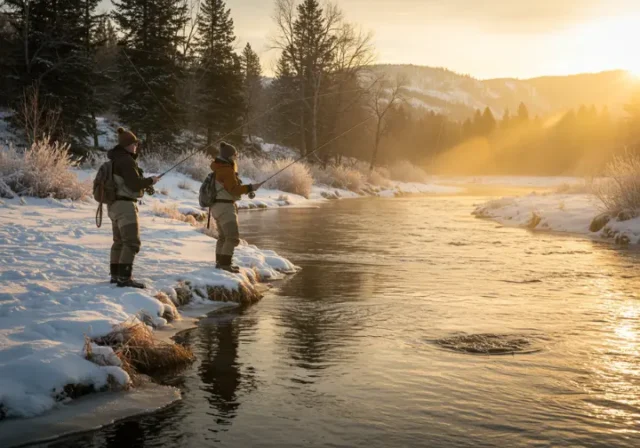In this article
Winter trout aren’t hiding—they’re conserving energy. You’ll find them in deep, slow pools and tailwaters, hugging the bottom. Downsize your flies to midges and micro-nymphs, adding tungsten beads and split shot to reach greater depth. Shorten your drifts and feel for subtle strikes; patience is essential. Don’t overlook overcast afternoons or periods of stable weather. Tactical adjustments, like stack mends, unlock winter success. Every angler knows the feeling of a winter tug is uniquely rewarding. Sharpening these strategies will bring those rewards to your line.
Understanding Winter Trout Behavior
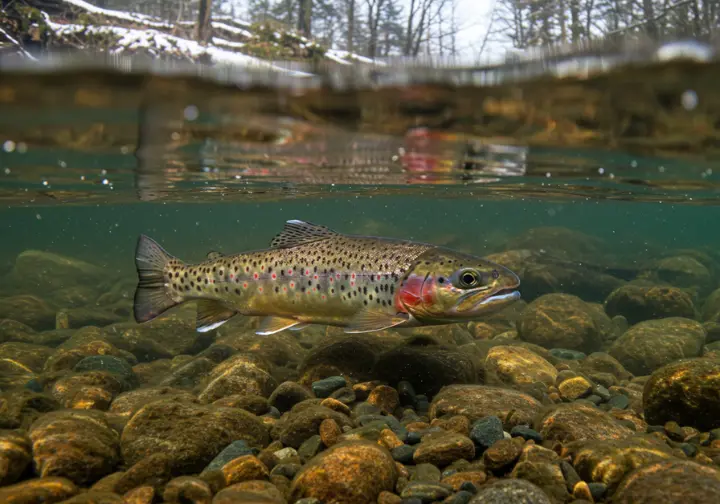
As colder waters settle in, trout slow down—unlike warmer months, their metabolism dips, and fast-moving meals lose appeal. Discover winter trout fly fishing strategies that keep your line tight and your catches coming.
Instead, they’ll seek out specific holding waters that offer shelter and consistent temperatures, like deep pools or areas with slower currents. Knowing where they’re likely to be and how they’re thinking is half the battle when fishing the season. These areas also often offer essential oxygen-rich environments as trout require water between 34-70 degrees to thrive.
Cold Water Metabolism Changes
When water chills, trout don’t simply stop feeding—they fundamentally change how they live. Their metabolism slows dramatically, sometimes by 50%, meaning these fishes conserve energy. You’ll find river trout hugging deeper, slower water; they aren’t chasing. Forget fast retrieves—they won’t move far for a meal.
Winter fly fishing demands precision, especially when nymph fishing tailwaters.
Focus your fishing techniques on presenting flies directly to where they’re holding.
Tailwater environments offer more stable temperatures and often provide good fishing, even during tough fishing conditions.
Don’t expect all-day action; feeding windows shorten to a few hours, usually afternoons.
Although winter presents challenges, recall even under the ice, trout can find increased foraging opportunities, and patience unlocks success. It’s a different game, but still rewarding, and understanding how they utilize eddy zones for cover and food can significantly increase your chances of success.
Prime Winter Holding Waters
Knowing trout slow down with the cold doesn’t just mean they’re lazier—it dictates where you’ll find them. During trout fishing, you’ll locate fish in deeper pools, especially those over four feet, as these offer energy conservation.
Don’t overlook seam lines where fast and slow currents meet; rainbows and brown trout feed here with little effort. Tailwaters below dams hold active trout since of stable temperatures, and spring-fed creeks provide consistently warmer water.
You’ll find fish hugging structure offering overhead cover – they need security. Sun-warmed sections during midday can trigger a feeding spree, so pay attention. Just as with walleye behavior patterns, trout will seek thermal refuges during colder months.
When fly fishing these trout rivers, focus on deeper run sections after riffles; food accumulates there. Recall, successful fly fish rely on grasping where trout hold during winter. Tight lines!
Essential Winter Fly Selection
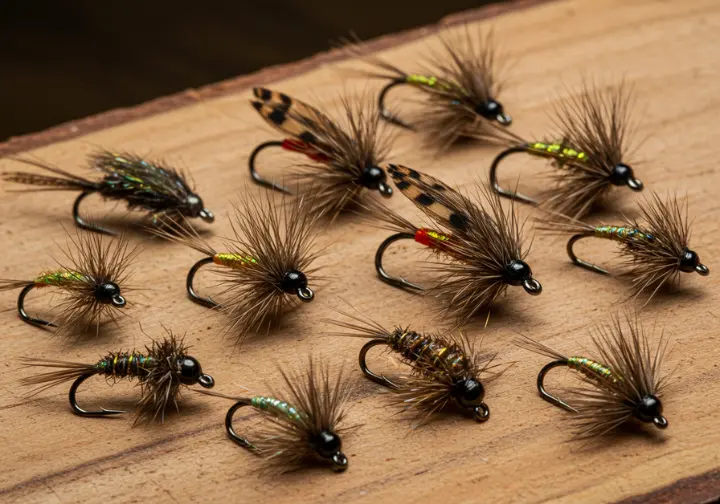
You’ll notice winter trout often feed slower and smaller, so you need to downsize your fly choices to match.
Don’t underestimate the influence of midge and micro-patterns, as these can be incredibly effective when trout aren’t actively rising.
We’ll additionally explore productive nymph and streamer tactics—understanding when to fish each will dramatically improve your success throughout the colder months. Considering water clarity is crucial, as fly colors should be matched to the conditions for optimal visibility to both the angler and the trout.
Midges and Micro Patterns
Since trout frequently change to small meals during winter, midges and micro-patterns become critical flies to have in your box. You’ll find midges comprise up to 80% of a trout’s diet in many trout water conditions, so sizes 20-24 are vital. Don’t underestimate black, cream, and olive flies; they consistently outperform others.
Consider the Disco Midge – its flashy thorax cuts through low light, helping the fly fisher see strikes.
Zebra Midges (18-22) remain reliable, especially near the bottom, and an angler fly with glass beads can beat metal in frigid water.
RS2 patterns bridge midge and mayfly imitations, proving versatile in small stream fishing and with small tailwater flies. To maximize success with these flies, carry multiple sizes; varying hatches demand it. Adapting your fly selection will increase your trout catch, and understanding effective presentation techniques is just as crucial for fooling winter trout.
Productive Nymphs and Attractors
When the water chills and trout settle into winter holding lies, switching to nymphs and attractors becomes integral for consistent action. You’ll find trout thrive even under the ice, but they’re selective. Don’t underestimate small nymphs—sizes 16-20 often outperform larger patterns during winter fly fishing. Think Pheasant Tail Nymphs, weighted to reach those key holding areas.
Consider Squirmy Wormies and scud patterns, especially in spring creeks and tailwaters. For productive wild trout fishing in small trout streams, small stonefly nymphs (12-16) are consistent producers. Egg patterns excel where trout spawn. Flashback nymphs cut through low-light conditions. Understanding strike indicator fundamentals is critical for detecting subtle takes in the colder months when fish are less likely to aggressively chase food.
| Fly Pattern | Emotion Evoked |
|---|---|
| Pheasant Tail | Subtle Confidence |
| Squirmy Wormy | Instinctual Strike |
| Egg Pattern | Anticipation |
You’ll increase your success by adapting your fishing to the season.
Winter Streamer Tactics
As small flies consistently fool winter trout, don’t overlook the potency of the streamer—a skillfully presented streamer can ignite a strike when nymphs aren’t getting attention. For winter fishing, especially in Montana rivers boasting healthy trout density, think smaller streamer fly patterns (sizes 6-10) mimicking available forage. White and olive consistently work well in clear, cold water.
You’ll find streamer fishing more effective with slow retrieves; keep the streamer near the bottom. Weighted, jigging streamers deliver precise presentations to where big trout hold. Try the “dead drift then swing” – it triggers reaction strikes from even sluggish fish. Articulated streamers offer subtle movement, tempting wild trout without exhausting them.
Don’t underestimate late afternoon river fishing, as fish species often feed aggressively before temperatures plummet. Adjust your fly line and fly tackle therefore for the effective fly fishing tactic, remembering that high-quality fishing tackles are essential for consistent fly performance.
Innovative Winter Techniques

You’ll find winter trout aren’t sitting still, so you need to change how you fish them.
We’re now looking at getting your fly deeper with new presentation methods, using tech to pinpoint fish, and timing your drifts for maximum impact. Utilizing bright options can be particularly effective in the often discolored winter waters. Don’t be afraid to experiment with these tactics – they’ll unlock opportunities when others are packing up for the season.
Deep Water Presentations
Since trout seek deeper, more stable water during winter, getting your fly down to them—and keeping it there—is critical. You’ll find tight-line nymphing, like Euro nymphing, shines; it maintains direct contact, vital in that trout fishery. Strategically add tungsten beads and split shot for precise depth control, reaching those winter-holding trout.
Understanding sinker weight selection is crucial as water depth and target fish species dictate the appropriate weight needed for effective presentation.
Don’t underestimate the stack mend—it creates the necessary slack as retaining depth in deep pools.
Consider two-fly rigs; a heavy anchor fly gets you down, as a lighter dropper covers more water. Longer leaders (12-15 feet) guarantee natural drifts. High trout counts often reside along the “bubble line,” where oxygenated water meets slower currents.
Use sighter material to detect subtle strikes, combating increased fishing pressure faced by these fisheries. Winter fly fishing demands you adapt; it benefits all fly anglers and the fly fishing industry.
Technology-Enhanced Approaches
Conquering winter trout requires just awareness of where fish hold—along this bubble line we talked about—but too equipping ourselves with tools which reveal their secrets. Now, fishermen employ GPS mapping to pinpoint and revisit productive waters, ensuring you find this trout concentration again.
Digital thermometers help you track water temperatures, predicting when game fish will feed, and weather apps reveal barometric pressure change—stable or rising often means happy fish.
Don’t overlook underwater cameras; they show you precisely where decent-sized trout are holding. Advanced strike indicators give you control, as polarized amber lenses maximize visibility when fish rising are subtle. Nymphing techniques are particularly effective during the winter months when trout are often feeding subsurface.
Mobile apps even track insect hatches, helping you select the right flies for wild trophy trout. You’ll land this trophy trout. You’ll better understand fish wildlife.
Tactical Timing Strategies
Here’s how you can maximize your time on Montana rivers:
- Fish mid-afternoon (12-3pm) for peak temperatures.
- Target stable weather, skip days with heavy precipitation.
- Hit tailwaters immediately after dam releases—expect trout to feed!
- Extend sessions on slightly warmer days.
- Overcast days often produce more strikes than sunny ones.
Essential Winter Gear
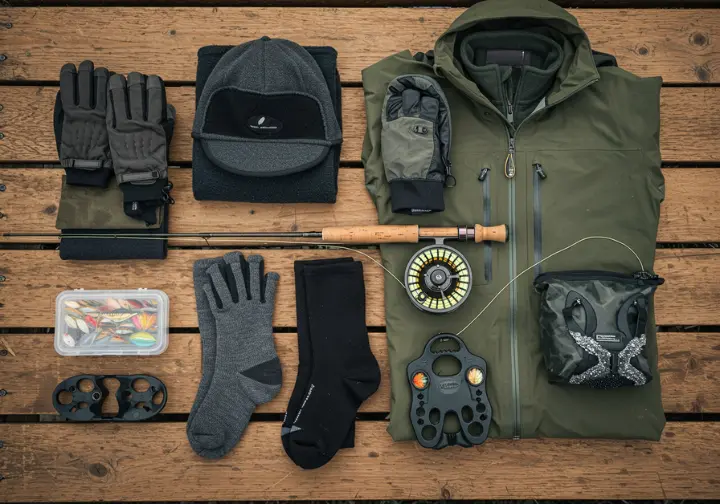
You won’t survive—or enjoy—a winter trout trip without the right setup, so let’s discuss gear.
Building an advanced layering system is critical for staying warm and dry when conditions change, and you’ll additionally want to contemplate specialized equipment like insulated boots and gloves built for handling frigid water.
Don’t overlook critical safety considerations either; things like ice cleats and a reliable communication device can truly save the day.
Advanced Layering Systems
Since staying warm is paramount when winter trout fishing, a thoughtfully constructed layering system isn’t just about comfort—it’s about safety and time on the water. You’ll extend your days pursuing brook trout in alpine lakes and cutthroat trout in larger lakes when you master that.
Don’t underestimate the potency of trapping air; it’s the core of staying dry and warm as fly-fishing.
Here’s what you need to ponder:
- Start with moisture-wicking base layers.
- Add insulating mid-layers like fleece or down alternatives.
- Protect yourself with waterproof, breathable outer layers.
- Keep your fingers working with fingerless gloves.
- Warm feet are crucial—neoprene socks and wool liners make a huge difference.
The fishing industry delivers cutting-edge options; recall, a comfortable angler is a focused angler, ready to work that fly rod, even in challenging conditions. Don’t let the cold dictate your fishing!
Specialized Winter Equipment
Beyond layering for warmth, successfully fishing for trout in winter often hinges on having the right specialized equipment. You’ll want a longer, softer rod—9 to 10 feet and 4-5 weight—to deliver a delicate dry fly presentation. Don’t underestimate a winter-specific floating line; its textured surface cuts through the cold. Fight fish with confidence using a reel with an oversized handle, even with gloves on.
Think about traction! Attach devices to your wading boots to avoid icy slips within the fishery.
Keep hydrated with an insulated bottle and warm up with a thermos. Waterproof your fly boxes—silicone inserts protect those vital winter patterns. If you’re planning a backcountry fly fishing adventure or a guided fishing trip for exceptional trout fishing in the mountain west, especially for the best fly fishing in montana, consider consulting with montana fishing guides; they’ll know what’s needed for outstanding fishing, even near elk wintering grounds.
Critical Safety Considerations
Winter fly fishing presents unique challenges, and prioritizing safety isn’t just smart—it’s critical for enjoying the season’s quiet beauty and incredible fishing. You’ll face conditions where even achievable fishing activities can become dangerous.
If you’re planning a diy fishing trip to Yellowstone or exploring a remote alpine lake fishing spot within a national forest, preparation is key, especially during solo fishing time. Recall, you might encounter few fish, but a safe return is paramount.
Don’t overlook these necessities:
- Always fish with a buddy.
- Pack a waterproof bag with extra clothes.
- Monitor weather forecasts closely.
- Test ice thickness—4 inches minimum—before crossing.
- Recognize hypothermia symptoms.
Keep your phone charged and let someone know your plans, including alternative fishing options or planned non-fishing activities. These fishing-specific destinations demand respect and careful planning.
Advanced Winter Tactics
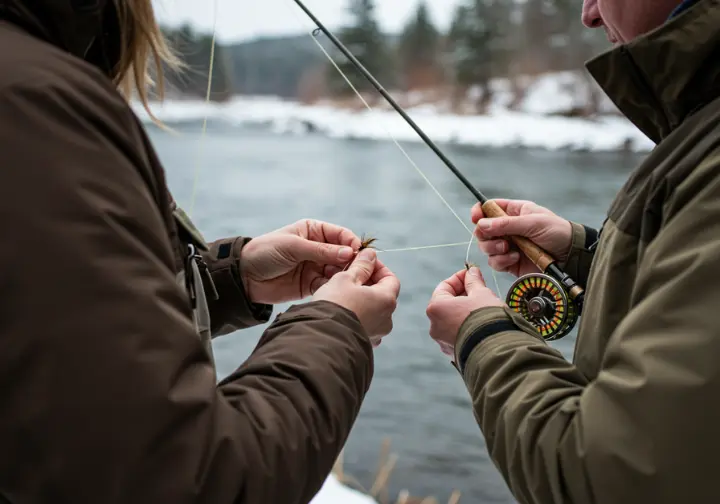
You’ve got your gear sorted, now it’s time to truly unlock winter trout—it isn’t just about slowing down, but refining how you present your fly.
We’re talking micro-adjustments to your drift, subtle fly manipulations which can trigger strikes when fish aren’t actively rising, and finding those overlooked seasonal opportunities others miss.
Comprehending these techniques will transform you from a winter angler to a winter trout hunter.
Micro-Adjustments That Matter
- Downsize your tippet by one size.
- Add split shot 6-8 inches above your flies.
- Shorten the distance between flies to 12-15 inches.
- Incorporate micro-pauses into your streamer retrieves.
- Focus your presentations on the deepest parts of pools.
Extend your leader 2-3 feet to cut drag.
Mend selectively to maintain depth and a natural drift.
Those changes will improve your game well before spring fishing arrives on that perfect trout stream for wade fishermen.
Advanced Fly Manipulation
As subtle movements often go unnoticed on warmer days, advanced fly manipulation becomes critical when trout are sluggish in cold water. You’ll notice the fish start reacting when you subtly vibrate your modern fly rods’ tip—the “wiggle drift”—imparting life to your dry flies. Don’t just let it drift; try a “stop and drop” after each mend to hit maximum depth.
From a drift boat, or during boat fishing, micro-jigging weighted nymphs mimics struggling insects.
Experiment with an “induced take,” slightly lifting your beautiful fly at the drift’s end. The “bounce back” – swinging then drifting upstream – looks natural. Even with streamers, “hover and twitch” in feeding lanes. Don’t forget the “drag and drop” with nymphs!
Mastering these techniques, utilizing a great all-around fly rod and even a dependable local fly, will extend your season well into the spring fishery.
Seasonal Opportunity Targeting
As winter’s grip tightens, astute anglers know opportunity doesn’t hibernate—it simply changes. You’ll find fantastic fly fishing isn’t confined to fall fishing or summer fishing; yearlong fly fishing is within reach with smart tactics. The Missoula fly fishing scene, including the Blackfoot River fishing, demands adaptation. Don’t overlook that pristine fishery—it’s a good fishery even in the cold!
Here’s how you unlock winter success:
- Chase mid-day blue-winged olive (sizes 18-22) hatches.
- Fish during stable barometric pressure after cold fronts.
- Target tailwaters during controlled releases for predictable feeds.
- Seek slightly discolored water—trout feed opportunistically.
- Focus on known “winter lies” for consistent results.
Spring creek fishing truly shines midday as water warms. A Montana fly and observant eye will reveal surprising activity.
You’ll discover trout aren’t sleeping; they’re simply adjusting.
Final Thoughts: Winter Mastery
Winter trout fishing isn’t just about enduring the cold; it’s about unlocking a different kind of angling experience—one built on a slower pace, careful observation, and a deeper appreciation of the fish. You’ll find solitude and quality fish when others aren’t on the water.
Think about it: Montana tops many lists for fly fishing regions, boasting a huge fishery and legendary status—Montana standards demand respect, even in winter.
Don’t just cast; target holding water with precise presentations. Master deep-water techniques and slow retrieves. Focus on midges and small nymphs, appreciating the trout’s slowed metabolism.
Explore western fishery opportunities for bountiful trout and spectacular fish, perhaps even native cutthroat trout. Life fly fishing becomes richer when you adapt. Use technology, stay safe, and recall, patience is key—you’ll be rewarded.
Popular Questions
Is a Fishing License Needed for Out-Of-State Winter Trout?
What’s the Best Way to Thaw a Frozen Fly Line?
Can I Use Floatant in Extremely Cold Temperatures?
Are Waders Necessary for Ice-Free Winter Trout Fishing?
What Are the Legal Regulations for Bank Fishing Access?
We are a participant in the Amazon Services LLC Associates Program, an affiliate advertising program designed to provide a means for sites to earn advertising fees by advertising and linking to Amazon.com. As an Amazon Associate I earn from qualifying purchases. We also participate in other affiliate programs. The information provided on this website is provided for entertainment purposes only. We make no representations or warranties of any kind, expressed or implied, about the completeness, accuracy, adequacy, legality, usefulness, reliability, suitability, or availability of the information, or about anything else. Any reliance you place on the information is therefore strictly at your own risk. Additional terms are found in the terms of service.


